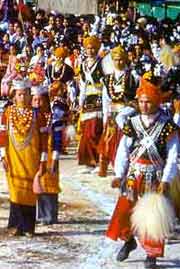|
Dance
 Dances are held at an open ground or premises of felling sad and public places.
There are two traditional dances of the Khasis. Dances are held at an open ground or premises of felling sad and public places.
There are two traditional dances of the Khasis.
1) Shad
Sukmynsiem or Weiking dance
2) Shad Nongkrem or Pomblang Nongkrem
The
Shad Sukmynsiem (Dance of the Blissful Heart) is popularly known as Shad
Weiking. It is so called after the name of the ground where the dance used to be
held every year. A thanksgiving festival , Shad Suk Mynesiem is a symbolic
offering of salutations to God, homage to their ancestors and proclamation of
unity of the Khasi people. There is no fixed date for this dance. It used
to be held during the month of April of each year. This is the most popular
dance among the Khasis. It is organised by the Seng Khasi (Khasi Religion). The
dances last for three days. Only unmarried men and women are allowed to
take part in the dance. Youngsters and damsels from different part of Khasi
hills participate in the dance. The Shad Sukmynsiem welcomes the whole of the
Khasi community to take part in the dance. There was no bar for any one to take
part in the dance since it is the traditional dance of the Khasis. Christians or
Hindus as long as they belong to Khasi community could take part in this dance.
Young lads brilliantly clad in colourful silk dhotis, coat and a plumed turban
and adorning glittering ornaments look like Rajput Princes. They dance around
with a sword or spear in one hand and a plume in the other. Pretty maidens in
magnificent many-splendoured silk-robes and elaborately decked in priceless
intricately designed ornaments of gold and silver and wearing a silver crown
emerge before use as apsaras from the world beyond. These 'angels' move in an
inner circle in two's and three's in tiny steps while the lads form a protective
ring around them and flashing their weapons. The embroidery on the girl's
apparel and the workmanship of their ornaments , many of them handed down for
generations as heirlooms, can made even an aristocratic millionaire
envious. It is difficult to see how the European missionaries could so
heartlessly condemn these fine expressions of blissful hearts as 'barbaric'. The
dancers dance rhythmatically making regular movements and keeping time with the
beat of the drum and pipe (Tanguari). Damsels (unmarried) dressed colourfully in
their very originality and making tiny steps in the centre while men folks with
swords and sometimes with shields in their hands encircling them.
 Another
folk dance of the Khasis, Shad Nongkrem is associated with Ka Pomblang
Nongkrem. Like all other ceremonies of the Meghalayans, it is performed to
propitiate the all powerful Goddess Ka Blei Synshar for a rich bounteous harvest
and prosperity of the people (subject). There is no fixed date for this
festival. It is generally celebrated in November of every year. Another
folk dance of the Khasis, Shad Nongkrem is associated with Ka Pomblang
Nongkrem. Like all other ceremonies of the Meghalayans, it is performed to
propitiate the all powerful Goddess Ka Blei Synshar for a rich bounteous harvest
and prosperity of the people (subject). There is no fixed date for this
festival. It is generally celebrated in November of every year.
The
Syiem of Khyrim accompanied by the high priest performs the Pomblang ceremony.
He offers oblation to a Lei Shyllong; the god of Shyllong peak by sacrificing a
cock. Goats are killed during the ceremony.
The
Nongkrem dance is associated with the Pomblang Nongkrem. When the ceremony has
been performed by the Syiem and the high priest, the Nongkrem dance starts. At
drawn-break on that day a maiden dance is held in which virgins from the Syiem
house take part and the Syiem Sad shaded by an umbrella, dance with great
solemnity.
This
is called an opening dance or royal dance which is generally done by the Syiem
before the dance starts. When the royal dance is finished, youngsters and
damsels of the Khyrim Syiemship enters the field and the dance of U Khun U Raiot
(subjects) of the Hima Khyrim (Khyrim Syiemship) starts. The dance lasts for
three days, the last day or the third day is the biggest of all. Unmarried males
Another
dance among the Khasis is Doregata in which the women try to knock off the
turbans of their male partners, using their heads. Another dance that the
performer dangles a pomelo or any other fruit on a cord tied to his waist and
then whirls it round and round after the initial impetus with a barely
perceptible movement of his hips. Some experts can control two separate pomelos
in this way.
The Garos have traditional dance called Do Dru-su'a in
which two women dance like doves pecking each other.
For
entertainment, the Pnars have their Laho
dance, in which members of both sex participate in their festival finery.
Usually two young men on either side of a girl , linking arms together dance in
steps. While in place of pipe and drum there is a 'Cheer leader', usually a man
with the gift of impromptu recitation who recite disrespectfully humorous lines
for the enjoyment of the audience.
|

